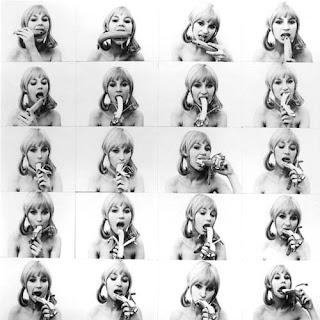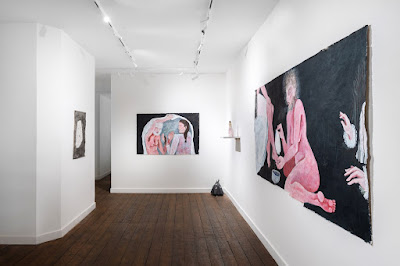Natalia LL at Roman Road
Natalia LL is a name that many gallery-goers will not be familiar with, yet she is one of the pioneers of feminist art in Poland, and this show at Roman Road, E2, is a brief celebration of the artist's work from the early 1970s; the video, photography and text-based pieces still feel invigorating, cheeky and as if they still have something to say in 2017.
The recurring figure present in these works is a young female with blonde hair tied into two ponytails either side of her head; this style can be instantly considered an immature one, and is the first point of discussion when viewing LL's work, as the schoolgirl character is repeated but never developed. As we will see, the artist amusingly pillories male sexual fantasies by testing the audience's responses to the gestures completed by the protagonist. Using the wittingly phallic symbol of the banana, and later a frankfurter sausage, the woman we identify solely from her hair colour stated in the artwork's title is choreographed to place the banana in and around her mouth suggestively. The element of the work's place in feminist history, or at least linear time scales, is interesting throughout, as it is situated post-sexual revolution and pre-internet pornography, resulting in the artist creating a space where she is free to express control of women's collective sexual depiction. Asking how effective the performance of these gestures are would would certainly make for an insightful debate.
The recurring figure present in these works is a young female with blonde hair tied into two ponytails either side of her head; this style can be instantly considered an immature one, and is the first point of discussion when viewing LL's work, as the schoolgirl character is repeated but never developed. As we will see, the artist amusingly pillories male sexual fantasies by testing the audience's responses to the gestures completed by the protagonist. Using the wittingly phallic symbol of the banana, and later a frankfurter sausage, the woman we identify solely from her hair colour stated in the artwork's title is choreographed to place the banana in and around her mouth suggestively. The element of the work's place in feminist history, or at least linear time scales, is interesting throughout, as it is situated post-sexual revolution and pre-internet pornography, resulting in the artist creating a space where she is free to express control of women's collective sexual depiction. Asking how effective the performance of these gestures are would would certainly make for an insightful debate.
Natalia LL, Consumer Art (Blonde Girl with Banana), 1972. Hand printed photograph on archival paper, 28cm x 39.4cm x 2cm framed. Roman Road, London.
Thinking about authority and ownership is a common motif in contemporary art, but the ways in which Natalia LL has addressed sovereignty over one's own body and how images of such may be disseminated or misconstrued are at times subtle. 'Natalia Silnia (!)' is a long (840cm x 80cm) printed vinyl, which hangs at the gallery ceiling and is draped down the wall and half way across the floor space, comprised of the artist's name at the top and bottom, but in between the letters are scrambled to, according to the gallery, create over a thousand word combinations. While for some artists such a piece would be viewed as a conceited project, where their name is concretely the beginning and the end, its inclusion in 'Probabilities' resonates with increasing opportunities for women, and prompts ideas of both collective and individual action, given that a thousand words with as many meanings can be found within the name of the artist.
The two video works cleverly continue to employ the visuals and ideas we have seen in the artist's oeuvre, yet are certainly more comparable to other feminist works, and what we might imagine feminist practices to involve. It is an ongoing discussion as to whether exposing the naked female form on film or in a photograph is a help or a hindrance to the feminist cause, with some compelling arguments on both sides, so it is interesting to see these results from the 1970s. In the video work 'Impressions', a female figure is seen handling her own breasts, before bouncing up and down in full view of the camera. Interestingly this figure is faceless throughout, and where the Blonde Girl with Banana has focus solely on her face and their suggestive gestures, at this point the viewer cannot escape the sight of these anonymous breasts. Although this represents objectification by selectively excluding any individual traits, in doing so we find a harsh critique of said objectification, as the body could belong to anyone and, to an extent, could be argued to be representing all women in its anonymity.
Natalia LL, Impressions (Still), 1973. DVD (from the original material 16mm), 3 minutes 46 seconds. Roman Road, London.
At a time where the feminist movement is struggling with internal fractures and fluctuating levels of success, retroactively viewing the work of Natalia LL not only serves to highlight how society has changed in the 40+ years since they were made, but equally how little has changed. Potentially the work has more potency for an early twenty-first century audience, as we are accustomed to the imagery used and can take the content further through deeper analysis. Roman Road's exhibition is a wonderful platform for artist and viewer alike; the former to showcase the Polish feminist art scene and gain further exposure in the UK, and for the latter a chance to witness a pioneer in avant-garde feminist art.




